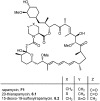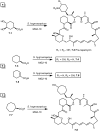Synthesis and biological evaluation of rapamycin-derived, next generation small molecules
- PMID: 30108899
- PMCID: PMC6072512
- DOI: 10.1039/c7md00474e
Synthesis and biological evaluation of rapamycin-derived, next generation small molecules
Abstract
Over the years, rapamycin has attracted serious attention due to its remarkable biological properties and as a potent inhibitor of the mammalian target of rapamycin (mTOR) protein through its binding with FKBP-12. Several efficient strategies that utilize synthetic and biosynthetic approaches have been utilized to develop small molecule rapamycin analogs or for synthesizing hybrid compounds containing a partial rapamycin structure to improve pharmacokinetic properties. Herein, we report selected case studies related to the synthesis of rapamycin-derived compounds and hybrid molecules to explore their biological properties.
Figures

















Similar articles
-
Rapamycin causes poorly reversible inhibition of mTOR and induces p53-independent apoptosis in human rhabdomyosarcoma cells.Cancer Res. 1999 Feb 15;59(4):886-94. Cancer Res. 1999. PMID: 10029080
-
The FRB domain of mTOR: NMR solution structure and inhibitor design.Biochemistry. 2006 Aug 29;45(34):10294-302. doi: 10.1021/bi060976+. Biochemistry. 2006. PMID: 16922504
-
Why Is Rapamycin Not a Rapalog?Gerontology. 2023;69(6):657-659. doi: 10.1159/000528985. Epub 2023 Jan 7. Gerontology. 2023. PMID: 36617414
-
Mammalian target of rapamycin: discovery of rapamycin reveals a signaling pathway important for normal and cancer cell growth.Semin Oncol. 2009 Dec;36 Suppl 3:S3-S17. doi: 10.1053/j.seminoncol.2009.10.011. Semin Oncol. 2009. PMID: 19963098 Review.
-
New inhibitors of the PI3K-Akt-mTOR pathway: insights into mTOR signaling from a new generation of Tor Kinase Domain Inhibitors (TORKinibs).Curr Top Microbiol Immunol. 2010;347:241-62. doi: 10.1007/82_2010_64. Curr Top Microbiol Immunol. 2010. PMID: 20549474 Review.
Cited by
-
Targeting SLC7A5 in lung squamous cell carcinoma: implications for cancer metabolism shift and boron neutron capture therapy resistance.Oncogenesis. 2025 Jul 23;14(1):26. doi: 10.1038/s41389-025-00568-z. Oncogenesis. 2025. PMID: 40701982 Free PMC article.
-
Isoginkgetin, a potential CDK6 inhibitor, suppresses SLC2A1/GLUT1 enhancer activity to induce AMPK-ULK1-mediated cytotoxic autophagy in hepatocellular carcinoma.Autophagy. 2023 Apr;19(4):1221-1238. doi: 10.1080/15548627.2022.2119353. Epub 2022 Sep 13. Autophagy. 2023. PMID: 36048765 Free PMC article.
-
Combined Deep Learning and Molecular Modeling Techniques on the Virtual Screening of New mTOR Inhibitors from the Thai Mushroom Database.ACS Omega. 2023 Oct 2;8(41):38373-38385. doi: 10.1021/acsomega.3c04827. eCollection 2023 Oct 17. ACS Omega. 2023. PMID: 37867669 Free PMC article.
-
In vitro Cas9-assisted editing of modular polyketide synthase genes to produce desired natural product derivatives.Nat Commun. 2020 Aug 11;11(1):4022. doi: 10.1038/s41467-020-17769-2. Nat Commun. 2020. PMID: 32782248 Free PMC article.
-
Rapamycin-inspired macrocycles with new target specificity.Nat Chem. 2019 Mar;11(3):254-263. doi: 10.1038/s41557-018-0187-4. Epub 2018 Dec 10. Nat Chem. 2019. PMID: 30532015 Free PMC article.
References
-
- Sehgal S. N., Baker H., Vezina C. J. Antibiot. 1975;28:727–732. - PubMed
-
- Vezina C., Kudelski A., Sehgal S. N. J. Antibiot. 1975;28:721–726. - PubMed
-
- Benjamin D., Colombi M., Moroni C., Hall M. N. Nat. Rev. Drug Discovery. 2011;10:868–880. - PubMed
-
- Schmelzle T., Hall M. N. Cell. 2000;103:253–262. - PubMed
Publication types
LinkOut - more resources
Full Text Sources
Other Literature Sources
Miscellaneous

